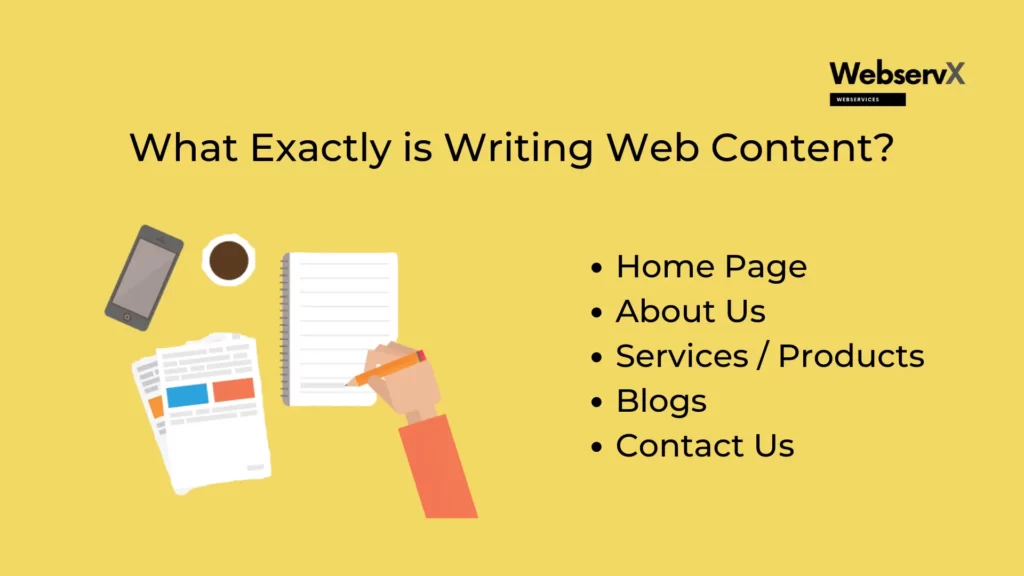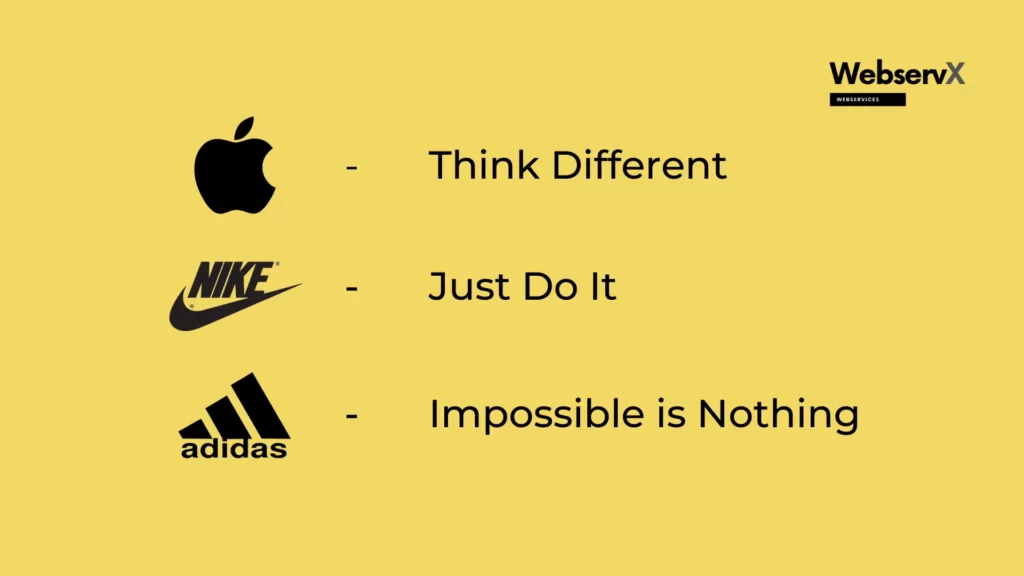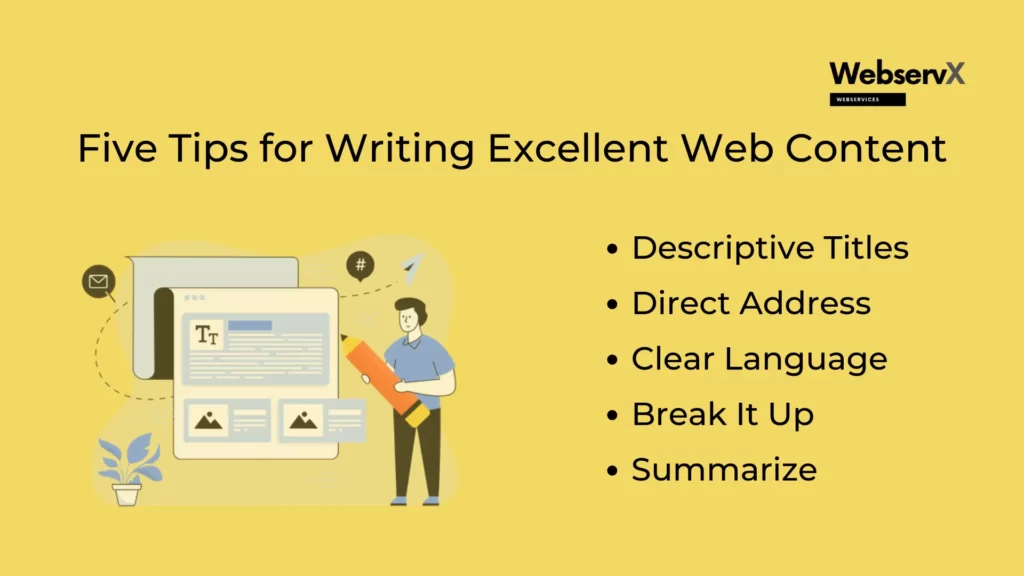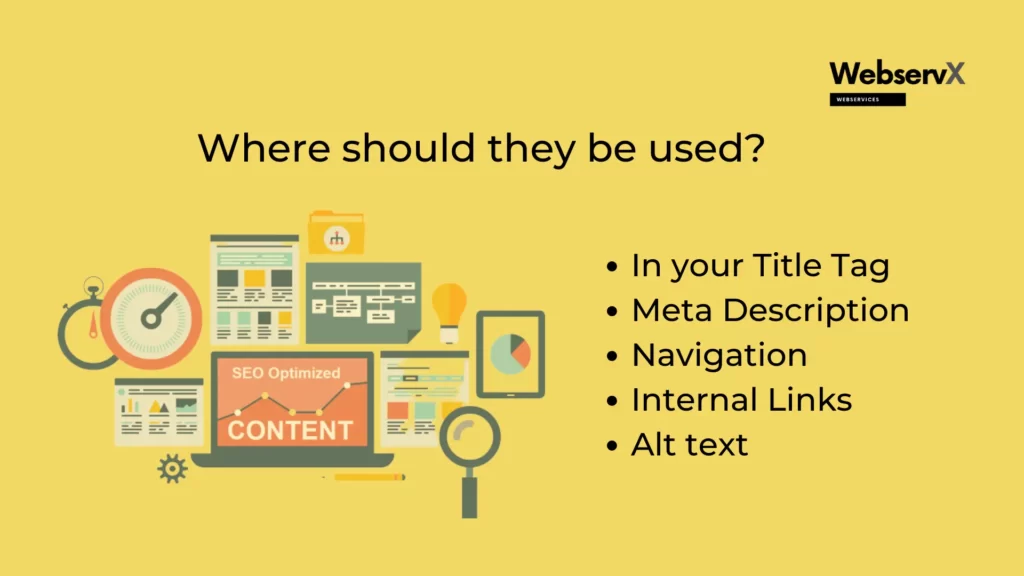7 Golden Rules for Writing Website Content
Writing website content follows a single rule.
It tries to inspire the reader to take action that benefits your company.
It wouldn’t be inaccurate to claim that your website’s content acts as a salesperson’s. Readers are more engaged by well-written information. It gives them the information they require. It makes them feel something. Therefore, engaging material facilitates the successful conversion of a reader into a buyer.
What exactly is writing website content?
It is the information that appears on a website page. It informs customers about your goods and services. Such information also demonstrates why you ought to pick this specific brand over rivals. A few of the pages contain

What Guidelines Will Increase the Impact of the Content You Write for Your Website?
Get rid of English grammar and use colloquialisms instead
We are all aware of how important it is to use Grammarly to check every piece of material. However, we wager that the tool’s assessment of the website content’s grammar will be subpar.
Consider the captions for well-known brands.

Grammarly will provide a typo alert for all three captions, or at least for two of them. However, they are wildly popular everywhere in the world.
So disregard everything your English teacher ever told you. When creating website content, you might incorporate slang phrases (or rather pepper them).
Keep in mind that Internet content is not read like a book. Stop writing a piece as though it
were a book, then.
Identify the web content’s readership
A buyer’s journey has three main stages, which are:

- Awareness – Introduce the brand through better visibility
- Consideration – Provide helpful information during the customer research phase
- Purchase – Convince interested users to be a customer
This is essential for creating website material of the highest calibre, according to experts.
Therefore, the purpose of your material should be to persuade readers to purchase your good or service. Several methods exist for doing this.
What’s in it for me? for the reader
Many web content pages go on and on touting how many features their product has. But if they don’t demonstrate how it helps readers, what’s the point?
Make the information relatable for the audience. Show them the advantages they will experience if they choose your goods and services.
Consider this illustration:
We have a group of content writers for our website. In this field, they have 11 years of experience. They have produced writing for several sectors.
The company is emphasized in each of the three sentences.
Instead, you ought to take a backseat in the story. The reader should be more of a priority while developing website content.
We may therefore reformat this as follows:
“Our website content writers can help you get high-quality content. Our experience will help you acquire new leads and use the content as an income generator. Get content now that is relevant to your market and intended audience.
Simply put: Avoid giving a monologue. Establish a two-way dialogue. Engage the readers more deeply.
Express a Human Touch
Take a look at these two phrases:
- Mobility application solutions with high performance, device independence, and vendor neutrality
- Mobile applications that function everywhere!
Readers will scratch their brains after reading the first sentence as they consider one devastating query.
Whoa, what are you even trying to say?
Many marketers believe they can dazzle readers by utilizing complicated language. Unfortunately, the reality is the exact reverse. Readers often turn away from comments like this that they don’t grasp.
Therefore, be kind to your content ambitions. Stop using obscure, jargon-filled language.
To make a long story short, avoid bragging about your knowledge. Instead, choose a language that your reader can comprehend. Therefore, be careful that the reader’s sensitivities are not offended by the level of technicality or jargon.
Avoid writing like a blog
The goal of a blog is to inform and educate.
The purpose of website copy is to quietly encourage a sale.
For writing website content, it must be obvious that each sentence or word aims to prompt a purchase.
You must deftly guide the reader into a purchase. Short sentences and clear language can do this. Some further advice is as follows:
- Instead of writing paragraph after paragraph, break them up with subheadings, as you would for a blog.
- Try experimenting with one-line paragraphs. Following this line, you can write a part of two to three lines.
- Blogs typically have a word count of at least 1200. But there will be significantly less internet copy (around 300 words)
Focus more on what readers receive rather than what you can do.
No one. Nobody is interested in what you can accomplish with your knowledge.
What then do readers seek?
It’s easy!
What can you do for them? is what they search for.
So instead of talking about oneself, do out following actions:
- Instead of using “we” and “our,” use more “you” and “your.”
- Instead of speaking at the readers’ level of comfort, simplify and align the language.
- Outline in detail the advantages they will experience by employing your product or service.
At the website’s conclusion, include a call to action.
Ensure that you make it plain to the users what they should do after reading the website material. You can choose from the following:
- Encourage them to visit other pages.
- Send them to the “Contact us” or “Enquire now” page, or
- Ask for subscriptions
Five Tips for Writing Excellent Website Content
Another excellent market for independent writers is the web. It’s already enormous and getting bigger every day. Given the abundance of online content, you must make yours stand out. Here are four strategies for attracting readers to your site material.

Descriptive Titles
Your article’s title should make clear to the reader what the content is about. While some people enjoy using comedy, others choose to keep things serious. As long as readers are aware of what to expect, it doesn’t matter. The motivation of the reader is important to them. They’ll know if the title is nice. One of the reasons why article titles with numbers do well is because of this. If the title of your post is “Seven Ways To Land Your Perfect Partner,” readers will know what to expect.
Direct Address
I adore writing web material because it allows me to speak directly to readers. It resembles speaking with a person who is in the same room. It’s a good idea to show your personality when writing website content because your writing voice typically sounds like your speaking voice.
Clear Language
You are writing for a global audience when you create digital material, and not everyone will share your native language. It is therefore advised to avoid using jargon and obscure terminology in favor of plain and simple language. To make things simpler for the reader to understand, you can also include examples.
Break It Up
You must make your site material consumable if you want it to be user-friendly. That entails dividing it into manageable portions, typically with one primary concept in each paragraph. Making the material scannable by including a subheading for each important concept is another smart move. As a result, readers will be able to quickly identify the major ideas by scanning the subheadings.
Summarize
If a statement is worthwhile, it should be repeated. Another effective strategy for ensuring that readers comprehend your post is to present the major points in a list of bullet points. Here is a summary of this article as an illustration. To design an effective web article:
- Pick a title with some detail.
- Speak to your readers as if they are present in the same space.
- Communicate clearly.
- With one key concept in every paragraph, make articles scannable.
- Write a summary.
4 Points to Note When Writing Website Content
Your customers can access you through your website content. It’s how you’ll generate interest in your company, introduce yourself, and set them up for success with whatever your ultimate objective may be. What should you keep in mind when you write it, then? How can you be confident that the information on your website achieves all of the goals you have for it?
Here are four things to think about while creating material on the web. To get you going, just a little bit.

Your Customers
Your content’s primary objective is to draw in new readers. You are vying for their interest and attention. However, just because you’re online and accessible to a worldwide audience doesn’t mean that EVERYONE has now decided to buy from you. They didn’t. Only residents who would gain from the goods or services you offer would be considered consumers. You should aim to produce content that will directly help them when you write it. You must do it too.
- Who are your customers?
- Why are they on your site?
- What natural questions will they have?
- What are their needs?
- What type of language will they understand?
- What will they respond to?
Your Goal
What do you want your website to achieve? Is it to generate interest in a product you’re trying to sell? Is it to establish yourself as the foremost authority on lawn care so that people turn to you when they require a landscaper? Is it to make people feel perplexed about the nuances of search engine optimization so they give up and call you for assistance when they do?
Whatever your site’s objective or conversion point may be, you need to produce content that will lead visitors there. But You must create a ton of introductory and tutorial-style content if you want to establish yourself as an authority on the subject matter. If you’re trying to market a service, you should give potential customers as much information as possible about what you do and how you stand out from the competition. You can better determine the direction of your material by understanding the site’s objectives.
The Search Engines
Although you shouldn’t write for search engines, you should keep them in mind as the majority of your clients will use one to locate you. They will enter the relevant search terms and rely on Google to identify the people who are pertinent to their inquiry. Therefore, you should maximize the use of your keywords to ensure that you appear for pertinent queries. The search engines will utilize your keywords to determine the subject matter of your site so they may show it to users when appropriate. You must provide them with plenty of suggestions by utilizing your keywords in clever ways for them to get the appropriate picture.
Where should they be used?

- In your Title Tag
- Meta Description
- Navigation
- Internal Links
- Alt text
Your Medium
Small business owners frequently “create” the content of their websites by copying and pasting text from print brochures that they have been distributing for years. This makes sense, in a way. After all, you already have the content! However, there are significant differences between print and online reading habits, and your site design should take this into account.
Several pointers for developing web content:
- Use bullets or lists (keep lists between 7-10 items long)
- Use links
- Keep lots of white space
- Write in short paragraphs
- Use headers and subheaders
- Use bold and italics
- Write as you speak
Six Questions to Remember When Writing Website Content
What is the main aim of the page?
This one is relatively easy. What is the purpose of this page? What do you hope users will do or think as a result of visiting the page? Every page should have a specific objective in mind, whether it’s to give visitors to the site a first impression of the company (such as on the homepage) or to persuade them to become leads after reading a product page. No matter whose page it is, each one should have a distinct goal and what you want the reader to do after reading or scrolling through it.
Who is the page trying to appeal to?
What are the main audiences’ objectives in viewing the page, and who are they? What are they seeking to learn? What are the personal objectives of any secondary or tertiary audiences as well? It will be impossible to write in a tone of voice that communicates to your readers if you don’t thoroughly get who they are and their personas (a depiction of their demographics, ambitions, and behaviors). What advantages does your company provide? What difference does your company make to them and them? Many businesses fall into the trap of bragging about their successes without ever genuinely elaborating on how those successes improve the experiences of their clients.
When does the page represent the buying cycle?
Have they just started down the funnel, are they about halfway through it, or are they near the finish and about to decide whether to engage with your goal CTA or not? Understanding how to write your material in the appropriate language and tone depends heavily on this. Are you still persuading, supporting your arguments, and demonstrating your reliability, or has a bond already been established between your brand and your target audience? Do you need to provide any additional assistance, value, or information, or should this page simply convey a transactional message that is very plain and direct? Recognize when to be explicit and when to keep assisting a consumer as they progress through the buying cycle.
What are the advantages and remedies you are promoting?
This is very significant! It will be one of the main factors in engaging a user and motivating them to keep browsing your website. Closely related to who your target market is, their requirements and problems, and how your company can make a difference. It will be a lot simpler to determine the messaging that is required in this situation to effectively express how your business improves theirs if you have already thought about who your audience is, their personalities, and the user groups they belong to.
What is the audience’s primary course of action?
What do you want the client to accomplish? Are you looking for them to click to learn more, download a white paper, phone, email, fill out a form, buy a product, or request a price for a service? Between persuasion and pushiness, there is a delicate line. Knowing the type of call to action that customers are more likely to respond to depends on knowing who your audience is. Every page should have a distinct call to action; some pages have multiple calls to action, while others only have one. A product page might include options to “add to cart,” “add to wishlist,” “read reviews,” “similar articles,” or even a comparison tool.
What phrases and keywords must be used?
Although it could be a little debatable, I usually give keywords and phrases the lowest priority. I have a clear notion of what I need to include as I write, but I wait to proofread or add any more keywords for SEO until the very end. I pay close attention to not overusing keywords or monotonizing phrases for the reader. Rich content shouldn’t be marketed using a list of keywords, and overusing certain terms or phrases is robotic. Don’t overuse or overcomplicate them; reserve them for the headlines, subheadings, meta titles, and a few scattered places within the text of the page.
